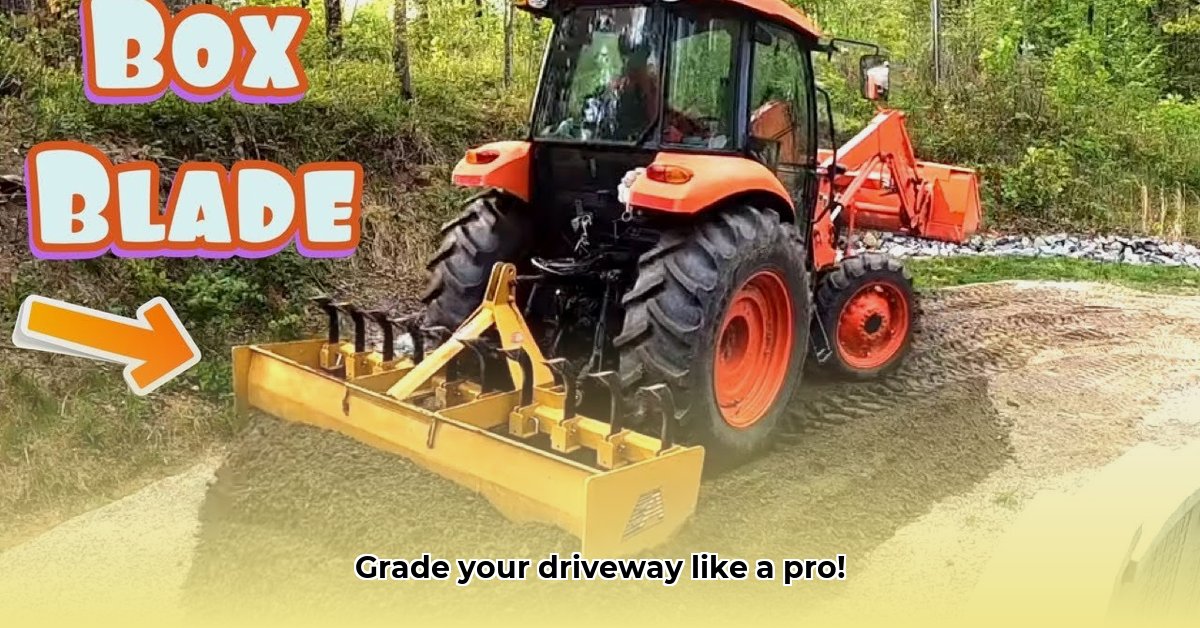
Got a bumpy, muddy driveway causing you headaches? This comprehensive guide will show you how to grade your driveway using your tractor, achieving a smooth, well-draining surface that stands the test of time. Even if you're new to tractor operation, this step-by-step approach, combined with safety precautions, will guide you to success. For optimal tractor performance, understanding your tire size is crucial; learn more about tractor tire sizes.
Getting Ready: Laying the Groundwork for Perfect Drainage
Before you start your tractor, careful planning is crucial. First, thoroughly inspect your driveway. Identify problem areas like potholes and recurring puddles. Poor drainage is a significant issue; addressing it upfront is key to a long-lasting solution.
Next, determine your gravel needs. The type of gravel impacts the driveway's longevity. For steeper inclines, larger gravel (like ¾-inch) interlocks better, resisting erosion more effectively. Estimating gravel quantity can be challenging, but overestimating is better than running short. A reliable rule of thumb is to add an extra 10-20% to your initial estimate.
Finally, evaluate your soil. Compacted soil hinders drainage. If you encounter stubbornly hard-packed areas, consider using a subsoiler or ripper attachment before grading. This pre-treatment significantly improves water penetration and overall drainage.
Choosing the Right Tools: Tractor Attachments for the Job
Selecting the appropriate tractor attachments is essential for efficient and effective grading. A box blade is highly versatile for initial leveling and moving significant amounts of material. For finer adjustments and finishing touches, a rear blade offers greater precision and control. If you’re dealing with substantial excavation or large potholes, consider using a backhoe. Remember, the right tool for the job saves time and effort.
The Grading Process: A Step-by-Step Approach
Let's grade that driveway! This numbered list provides a clear, actionable plan:
Initial Leveling (Box Blade): Start with a shallow box blade setting to smooth out major bumps and dips. Overlap passes slightly for even coverage. Focus on addressing larger irregularities. Safety First: Always operate the tractor at a safe speed, maintaining firm control.
Fine Grading (Rear Blade): Once the initial leveling is complete, switch to a rear blade (if used) for finer adjustments. Work incrementally, making gradual changes to achieve a consistent slope. Tip: Take your time; precision is key at this stage.
Creating Proper Drainage: The Crown: Incorporate a slight crown (a gentle rise in the center) to direct water runoff to the sides. This prevents pooling and erosion. Remember: A properly crowned driveway significantly extends its lifespan.
Compaction: Settling the Gravel: After grading, repeatedly drive your tractor over the driveway, compacting the gravel. This ensures a stable, even surface. Address any minor imperfections after compaction. This step is critical for long-term driveway stability.
Top-up (If Needed): After compaction, you might need to add more gravel to maintain a consistently level surface. Always start with smaller adjustments and assess the impact before adding excessive amounts.
Maintaining Your Driveway: Long-Term Care
Regular maintenance is crucial for a long-lasting driveway. Consistent monitoring and timely attention to minor issues prevent them from becoming major problems. Pay attention to seasonal effects: freeze-thaw cycles and winter snow removal can significantly impact the driveway's integrity. Prepare for necessary post-winter maintenance.
Troubleshooting: Addressing Common Challenges
Uneven Grading: This often results from inconsistent blade depth or insufficient overlap. Slow down, double-check blade settings, and ensure adequate overlap.
Poor Drainage: Adjust the crown, address compacted soil areas, or consider deepening drainage ditches. Addressing drainage issues proactively is essential.
Excessive Gravel Loss: Using larger gravel on steeper slopes can help retain material. Gravel stabilization techniques may also be necessary.
By following these steps and utilizing appropriate safety precautions, you can transform your bumpy driveway into a smooth, well-draining asset for years to come. Remember – safety is paramount. Always wear appropriate safety gear and operate your tractor responsibly.